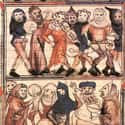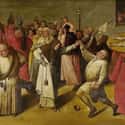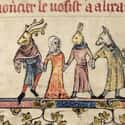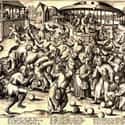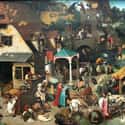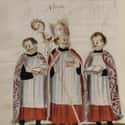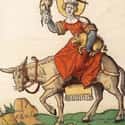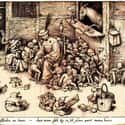-
(#1) People Hid Their Identities By Crossdressing And Covering Themselves With Animal Dung
The concept of inversion was at the core of the Feast of Fools. The people at the bottom of the social hierarchy had a single day to act like the most powerful in society. For example, students hid their identity and parodied their social betters: clergy, teachers, and rulers. Sometimes, the students rubbed mud on their faces – or even animal dung – or simply wore a mask. Men dressed as women and women as men, to invert the traditional gender hierarchy. And everyone sang, danced, and drank.
-
(#2) Monks And Nuns Were The Wildest Partiers Of All
Because the Feast of Fools was all about breaking rules, the wildest partiers were often the people who lived by the strictest commandments the rest of the year: monks and nuns. As French theologian Jean Gerson ranted in 1402, the Feast of Fools was full of, "abominable disorders" and, "great, detestable abuses done in the kingdom of France, in diverse churches and abbeys of monks and nuns." And Gerson was correct that many of the festivities took place in churches.
Maybe it isn't surprising that the Feast of Fools began at the same time the Catholic Church officially said all priests had to be celibate. During an era when monks, nuns, and priests were expected to live up to even higher standards, they wanted one day to break all the rules and celebrate.
-
(#3) The Church Tried To Ban Masks Entirely Since People Acted Crazier In Disguise
Even though the Feast of Fools was a wild party with no rules, people still wanted to hide their identities. After all, they were throwing dice in church and singing obscene songs. So, many medieval partiers showed up for the Feast of Fools wearing masks.
The authorities knew that the masks only made people more wild, so they tried to ban masks. In 2017, Pope Innocent III complained about "masked shows" that took place in church during Christmas season. In Lille in 1398, the church declared that masks were banned at New Year's celebrations. Another church complained in 1404 that the clergy were wearing "masks in the shape of devils."
-
(#4) The Catholic Church Banned The Party For Blasphemy
According to the Catholic Church, the Feast of Fools was extravagant to the point of blasphemy. It's no surprise that a celebration of disorder didn't find favor with the church, especially when the parties often took place inside churches. But the church had a hard time stamping out the tradition, which was incredibly popular.
In 1445, the theologians at the University of Paris wrote a letter condemning the practice. They described the events in horrified terms:
Priests and clerks may be seen wearing masks and monstrous visages at the hours of office... They dance in the choir dressed as women, panders or minstrels. They sing wanton songs. They eat black puddings... while the celebrant is saying mass. They play at dice... They run and leap through the church, without a blush at their own shame.
After this condemnation, the Catholic Church officially banned the Feast of Fools in the 1400s. But the parties continued for at least another century.
-
(#5) Gambling Was Made Legal For The Day
All the rules were lifted: prohibitions on gambling for money were repealed for a single day, so everyone gambled. As one scholar explains, "There were no regulations: on this day, people were permitted to do everything that was forbidden during the rest of the year." And people definitely took advantage.
-
(#6) Medieval Christmas Involved A Lot Of Solemnity – People Needed To Cut Loose After
In the medieval period, Christmas involved a lot more fasting than it does today. Medieval Christians spent the month before Christmas fasting in observance of Advent, which was supposed to help prepare for God's coming. And they didn't just mean the birth of baby Jesus – they also meant the coming apocalypse. All in all, it was a pretty serious time. On Christmas day, worshippers spent most of the day in church: three masses were said on Christmas.
After all the serious fasting and rituals associated with Christmas, many medieval Christians wanted to cut loose with a massive party.
-
(#7) Ironically, The Church Started The Tradition As A Celebration Of The Gospel
Ironically, even though the Catholic Church condemned the parties, they most likely started the tradition. Even though the Feast of Fools was often chaotic and sometimes violent, it originally had a very specific purpose: to play-act the verse in Matthew 20:16 where Jesus said, "the last will be first, and the first will be last."
For a single day during the Feast of Fools, according to scholar Max Harris, the lowest clergyman would switch places with the bishop. It was a reaffirmation of Jesus' promise that the last would be first. In many places, a "boy bishop" was crowned. When the boy bishop marched through town, even the real bishop bowed down. However, even though it had a loose connection to Jesus' words, the tradition could easily spiral into a riot.
-
(#8) (Naturally) Boy Bishops Abused Their Power
The boy bishop would take the real bishop's robes, miter, and ring. His followers put on their vestments backward. The boy bishop recited nonsense prayers and demanded donations. And the whole event usually devolved into obscene songs and drinking in the church.
The Feast of Fools might have started with a religious purpose, but it quickly spiraled out of control. With one day to unleash the resentments of an entire year, the revelers quickly grew rowdy. Boy bishops preached that their teachers should be hung from trees. They demanded "donations" from the community. In some places, boys donned masks so they couldn't be identified when they caused trouble.
-
(#9) 'The Song Of The Ass' Was About A Donkey
Even a seemingly holy song could easily devolve into chaos. At early celebrations of the Feast of Fools, the revelers sang a "song of the ass." It was about a donkey taking a long journey. In the song, the donkey crosses the river Jordan and visits Bethlehem. The story, sung in church during the week of Christmas, evokes the Biblical tale of Mary and Joseph traveling by donkey just before the birth of Jesus.
However, the song often got out of hand. In some cases, people led an actual donkey into the church, which was bound to cause problems. On another occasion, a rowdy person smacked a cleric with "an inflated and swollen hen's bladder" during the song.
-
(#10) The Feast Of Fools Shows Up In Disney's 'The Hunchback Of Notre Dame'
The medieval tradition of the Feast of Fools was so enduring that Victor Hugo included it in his 19th-century classic The Hunchback of Notre Dame. During the party, Quasimodo is crowned King of Fools, sticking with the theme of inverting the social order.
In the Disney version, the Feast of Fools is renamed "Topsy Turvy Day." As the song declares, "It's the day for breaking rules, Come and join the feast of Fools!" And just like the medieval Feast of Fools, the Disney song celebrates turning life upside down and making every man a king and every king a clown. "It's the day the devil in us gets released, It's the day we mock the prig and shock the priest."
-
(#11) The Party Had Roman Roots
The Feast of Fools shared a number of similarities with the Roman festivities of Saturnalia. During Saturnalia, a celebration of the Roman god Saturn, social roles were also reversed. A mock king was chosen, and slaves were allowed to do what they wanted for a day. And Saturnalia was also celebrated around Christmas time – in fact, the Roman celebration likely influenced how Christians celebrate Christmas.
If the Feast of Fools did have Roman roots, it's less surprising that the Catholic Church wanted to condemn it, even if the celebration originally started to honor a Gospel verse.
-
(#12) The Feast Of Fools Wasn't The Only Huge Winter Party
The Feast of Fools wasn't the only enormous party in the dead of winter. By that time of year, people across Europe were ready to blow off some steam, so there were a number of parties that took place in late December and early January. In some places, for example, the same kinds of parties occurred during Carnivale, the period just before Lent.
New Random Displays Display All By Ranking
About This Tool
April Fools' Day is an ancient festival in European history. In modern times, April Fools' Day is a festival for joking with each other, but the Europeans in the Middle Ages attached great importance to these days and their celebrations were extremely crazier. It can be said that it was the feast of fools that allowed people in the Middle Ages to spend a long and hard time. The Middle Ages is not a beautiful era in people's ideas.
At that time, the serious and hard-line medieval church not only did not suppress this recreational activity but supported and encouraged such activities in the feast of fools. The random tool introduced 12 extreme things of the Medieval feast of fools.
Our data comes from Ranker, If you want to participate in the ranking of items displayed on this page, please click here.











